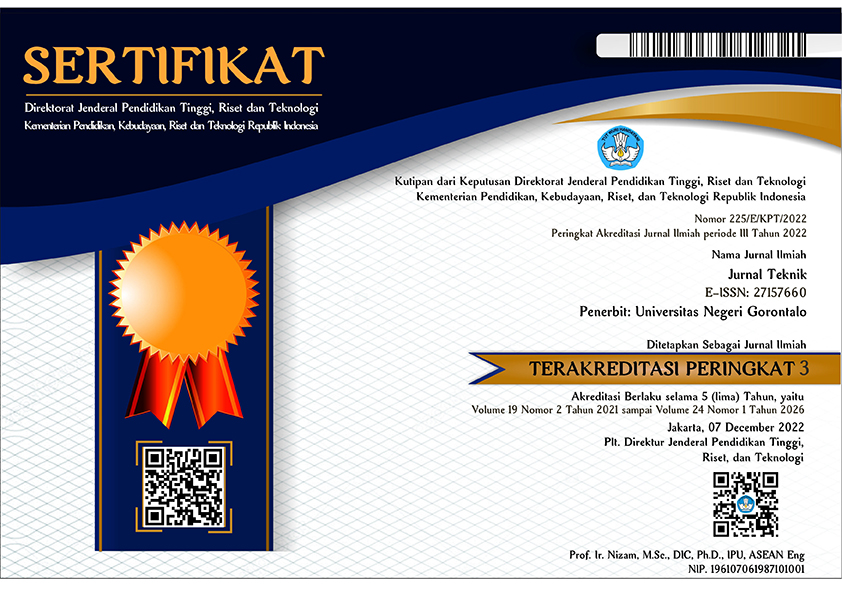Pengaruh Penggunaan Abu-Sekam Padi sebagai Bahan Tambahan Terhadap Kuat Tekan Beton
Abstract
Concrete in its use as a construction material continues to increase and is increasingly widespread. The high level of use of concrete is caused by the many advantages offered by the use of concrete. Additives in concrete are one of the materials in concrete that can be innovated to obtain concrete characteristics and specifications. Additive material used in this research is rice husk ash. Rice husk ash used as an additive in this study was rice husk ash waste from Kerinci Regency. This research was conducted.with the aim of knowing how the use of rice husk ash as an additive can affect the compressive strength of concrete. The concrete used is cylindrical concrete with a concrete design quality of fc' 20 MPa. This research was conducted by experimental method. The results of the study with variations in the addition of rice husk ash to concrete as much as 0%, 6%, 8%, 10%, and 12% to the weight of cement obtained an optimum compressive strength value of 29.32 MPa. Laboratory tests on the compressive strength of concrete proved that the compressive strength.of concrete increased linearly with the addition of 6%, 8% and 10% rice husk ash.
Downloads
References
ACI 234R-96. (2006). 234R-06 Guide for the Use of Silica Fume in Concrete. Aci 234R-96, 96(Reapproved), 0–64.
ASTM C33-03. (2003). ASTM C33- 03 : Standard Spesification for Concrete Aggregate. Annual Book of ASTM Standards, 04, 1–11.
Badan Standarisasi Nasional. (1990). SNI 03-1968-1990. Metode Pengujian Analisis Saringan Agregat Halus dan Kasar. Jakarta: Badan Standarisasi Nasional.
Badan Standarisasi Nasional. (2011). SNI 1971:2011. Cara Uji Kadar Air Total Agregat dengan Pengeringan. Jakarta: Badan Standarisasi Nasional.
Badan Standarisasi Nasional. (2016). SNI 1969:2016. Cara Uji Berat Jenis dan Penyerapan Air Agregat Kasar. Jakarta: Badan Standarisasi Nasional.
Badan Standarisasi Nasional. (2016). SNI 1970:2016. Metode Pengujian Berat Jenis dan Penyerapan Agregat Halus. Jakarta: Badan Standarisasi Nasional.
Heldita, D. (2018). No Title. Pengaruh Penggunaan Abu Sekam Padi Terhadap Kuat Tekan Beton (Agregat Kasar Ex Desa Sungai Kacil, Agregat Halus Ex Desa Karang Bintang, Abu Sekam Padi Ex Desa Berangas).
Hidayat, A. (2011). Pengaruh Penambahan Abu Sekam Padi Terhadap Kuat Tekan Beton K-225. E-Journal Aptek, 3, 162.
Holland, T. C. (2005). Silica Fume User’s Manual. Washington. Federal Highway Administration, 194.
Mulyadi et al. (2021). Analisis Pemanfaatan Limbah Abu Sekam Padi Sebagai Pengisi dalam Campuran Mutu Beton K.250. Sumatera Selatan: Universitas Palembang.
Nugroho, P. A. (2020). Analisis Pengaruh Penambahan Abu Sekam Padi (Rice Husk Ash) sebagai Upaya Pengurangan Penggunaan Semen Portland pada Beton Normal (Menggunakan SNI 7656-2012). Tegal: Universitas Pancasakti Tegal.
Sandya Y., Prihantono, dan Musalamah. S. (2019). Penggunaan Abu Sekam Padi sebagai Pengganti Semen pada Beton Geopolimer. Jakarta: Universitas Negeri Jakarta.
SNI 7656:2012. (2012). Tata Cara Pemilihan Campuran untuk Beton Normal, Beton Berat dan Beton Massa. Badan Standarisasi Nasional, 52.
Tamimah, K. N., Bahar, F. F., & Nuklirullah, M. (2022). Pemanfaatan Tumbukan Cangkang Kerang sebagai Pengganti Sebagian Agregat Kasar pada Campuran Beton. Fondasi : Jurnal Teknik Sipil, 11(2), 108. https://doi.org/10.36055/fondasi.v11i2.16623
Tata, A., & Sultan, M. A. (2016). Pengaruh Penambahan Abu Sekam Padi Sebagai Campuran Bahan Baku Beton Tetrhadap Sifat Mekanis Beton. SIPILsains, 06, 23–30.
Copyright (c) 2023 MUHAMMAD FARHAN, MUHAMMAD NUKLIRULLAH, FETTY FEBRIASTI BAHAR (Author)

This work is licensed under a Creative Commons Attribution-ShareAlike 4.0 International License.













